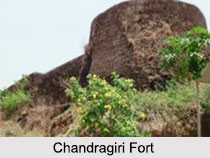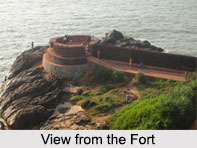 This ancient riverside fortress is situated in Kasargod district, Kerala, standing majestically on a hilltop with the scenic background of the Chandragiri River joining the Arabian Sea. The Chandragiri Fort is a part of several other chains of forts which was built by Sivappa Nayaka, the ruler of the Nayakas of Bednore.
This ancient riverside fortress is situated in Kasargod district, Kerala, standing majestically on a hilltop with the scenic background of the Chandragiri River joining the Arabian Sea. The Chandragiri Fort is a part of several other chains of forts which was built by Sivappa Nayaka, the ruler of the Nayakas of Bednore.
Historical Significance of Chandragiri Fort
Chandragiri fort is an archaeological masterpiece built in the 17th century by the Kolathunadu kings. Throughout history the fort has been a witness to bloodshed and warfare among the local clans and when the kings of Kasargrod province, the Thulunadus lost a long battle with the Vijaynagar Empire, the fort was conquered. The geographical positioning of the fort was appropriate being near the sea and river to facilitate better transport and agriculture. Being located on a hilltop, it also provided a high vantage point during attacks to monitor the movements of the invaders. The constant wars had ruined the fort, though most of it was restored and rebuilt by Sivappa Nayaka.
Architectural Importance of Chandragiri Fort
The strategic placement of the fort on a hilltop occupying almost 7 acres of land and 150 feet above the sea level is ideal. The large fortified square structure of the building provides a huge space for storage. There are vacant grounds which were for assembling purposes. The Kolathunadus used an efficient system of water supply in the fort. A deep well and a large pond site were built inside the fort to facilitate the water supply. Unlike other forts, this fort has two cave entrances and the normal entrance is built of a big arch door. The thick walls of this majestic structure were built by granite, rock stones and lime-stone pastes. Large holes were made on the walls at strategic angles to place huge artillery and ammunitions. This fortified architectural beauty was designed for security purposes.
 Tourism in Chandragiri Fort
Tourism in Chandragiri Fort
Chandragiri Fort is one of the heritage sites in Kerala and is a famous tourist attraction. The unique features of the fort draw the attention of the people. The confluence of the sea and river is a sight to behold and is breathtaking from the fort at sunset. There is a beautiful bridge over the Chandragiri River at Thekkil at the distance of five miles from Chandragiri. A mosque is situated nearby and the view of the bridge with the mosque in the background is one of the most attractive sights on a drive along the NH 17 from Kannur to Kasargod. A longest railway tunnel in Kerala passes through Chandragiri Hills. A boat club has been recently started there.
The monsoon seasons from July to November are the appropriate time to view this fort under dark stormy clouds. Chandragiri Fort can be accessed by air, train and road. The nearest airport is in Mangalore which is at proximity to Kasargod Town. There is also the Kasargod Railway station which is well connected, or one can use private and government operated vehicles to reach the fort. The fort is open seven days a week from 10 am to 5 pm.



















